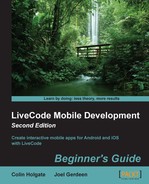- Go to the Keepers card and create a MobGUI button for Prev, Next, and Play Media. Make a MobGUI Multiline field and name it
mediaURL. Be sure to uncheck the Auto delete option, so that it keeps the URL data when we change cards. Also uncheck the Editable option. You should now have something looking like the following screenshot:
- Add these lines to the
mouseUphandler of the Prev button:if the number of this card is > 5 then go previous end if - Add these lines to the
mouseUphandler of the Next button. Note that- 1is used since the last card is the MobGUI card:if the number of this card < the number of cards - 1 then go next end if - Add this line to the Play Media button's
mouseUphandler:showMedia the mgText of group "mediaURL"
- Select the four controls and Group them. Check the box that says Behave like a background. Name the group
keeperbuttons. - Edit the script of the new group. Add this
refreshhandler:on refresh set the itemdelimiter to "." if char 1 of the last item of the mgText of group "mediaURL" is "m" then show group "Play Media" else hide group "Play Media" showMedia the mgText of group "mediaURL" end if end refresh - We need to go back and add things to the Media card.
- Go to the Media card and add a MobGUI button. Set the name and label to
Keep Media. - One tricky thing is that media will play full screen on smaller screens and by the time you see the Keep Media button, the video has already gone away. We can work around this by storing the URL of the last shown media in a global variable.
- In the Media card script, change the
initfunction, so that the later lines read like this:if the result > 0 then put the result into tMediaLine put line tMediaLine of gMediaList into gLastMedia showMedia gLastMedia end if
- Change the global variable declaration line to include the
gLastMediavariable. - Set the
mouseUphandler of the Keep Media button to be this:on mouseUp global gLastMedia go card (the number of cards -1) if the mgText of group "mediaURL" is not empty then new card end if set the mgText of group "mediaURL" to gLastMedia save stack "WebScaper" as (specialFolderPath("documents") & "/WebScraper.livecode") send "refresh" to group "keeperButtons" end mouseUp - Now, only one last step is required for the stack to save the media. We need to create a launcher app like we did earlier in this chapter. Create a stack named
LaunchScraperwith the following stack script:on openStack set the defaultFolder to specialFolderPath("Documents") if there is not a file "WebScraper.livecode" then put the filename of this stack into masterfile set the itemdelimiter to "/" put "WebScraper.livecode" into the last item of masterfile put specialFolderPath("engine") & "/WebScraper.livecode" into masterfile put specialFolderPath("Documents") & "/WebScraper.livecode" into appfile put URL ("binfile:" & masterfile) into URL ("binfile:" & appfile) end if go stack specialFolderPath("Documents") & "/WebScraper.livecode" answer the filename of this stack end openStack - Make sure that the Launch Scraper and Web Scraper apps are in the same folder. Open only the Launch Scraper app and make sure that the Web Scraper app is included in the Copy files of the Standalone Application Settings.
- Select your Test Target device and then Test. Note that the last answer statement will display the path and the filename where the main app is stored on your device. This can be commented out once you are comfortable that it is working.
- Use the Browser card to load a page with plenty of images, videos, or sounds on it and go to the Media card to see those listed.
- Select any item followed by a click on Done.
- If you like the image, sound, or video, use the Keep Media button to go to the end of the stack to save the media's URL.
- Choose more bits of media and keep them.
- Go to the Keepers section and use the Next and Prev buttons to browse through the items you've kept.
- The images should appear automatically and the video and audio can be started with the Play Media button.
We added the last feature of our application, a set of cards where we can go to view the bits of media that we've chosen to keep.
If you do make the Web Scraper app and start to find it useful, it's quite likely that there will be a set of web pages that you'd like to go back to again and again. To type the URL every time would be tedious. So, why not make a hidden field on the Browser card and type in a list of your favorite pages. Add a button to the card too, which will bring up a list of those pages for you to choose from. The one you choose can then load the Browser control at the desired page. All of the steps to do this were covered in the The Links card section.
It's pretty certain that if you've carefully followed all the steps in this chapter and indeed all the steps were perfect, you still wouldn't have an app ready to be submitted to the app stores! You would require a splash screen, a main menu, icons on the tab buttons as well and some love from a graphic designer! Feature wise, it would be nice if the images you keep could be zoomed and panned.
